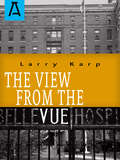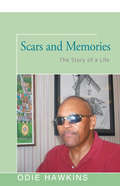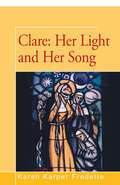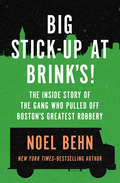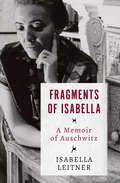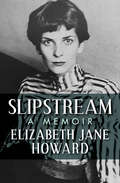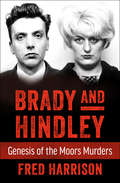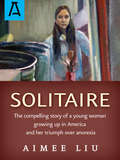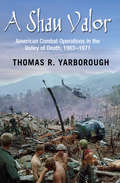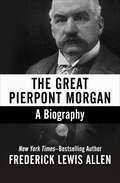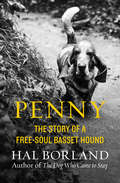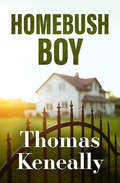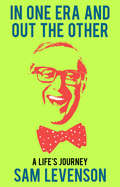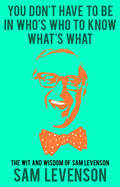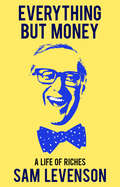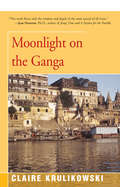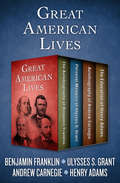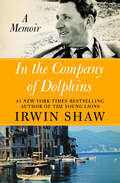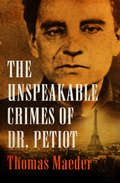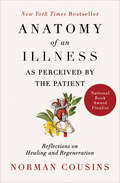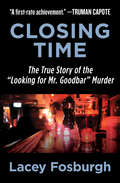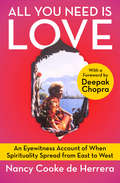- Table View
- List View
The View from the Vue
by Larry Karp"We called it THE VUE, and without a doubt, that was the most complimentary nickname Bellevue Hospital ever had. " So begins The View from the Vue, an "entertaining, colorful recall" (Publishers Weekly) of life a half-century ago at New York City's medical court of last resort. Between 1959 and 1965, Dr. Larry Karp served as medical student, intern, and resident physician at Bellevue. During these six years, he came to know and understand the people who wended their way through the dingy hallways and roach-infested subterranean passages, and inhabited the sparsely furnished wards of the fabulous hospital whose origins date back to 1811. It's not surprising that Dr. Karp has never been able to forget The Vue. Writing in a style both human and humorous, he recalls some of the astonishingly funny and dramatic events he lived through, involving bizarre patients and grotesque working conditions. In the process, he gives us a clear picture of what it was like at Bellevue in the early sixties . . . for both doctors and patients.
Scars and Memories: The Story of a Life
by Odie HawkinsThe deeply personal story of Odie Hawkins's journey, from "the poorest of the poor" childhood in Chicago to Hollywood screenwriter--and the people who deeply mattered. A tough, touching autobiography.
Clare: Her Light and Her Song
by Karen FredetteClare: Her Light and Her Song is a vivid portrait of a strong woman who scandalizes family and friends to follow her beloved mentor, Francis of Assisi, in a life of joyous poverty. Thoroughly researched, this biography faithfully depicts Clare as seen by her contemporaries, including cardinals and popes. Her story is enriched by accounts of the wars, political intrigues, and towering figures of the tumultuous thirteenth century in which she played a significant role. The first woman to receive Papal approval for her own Rule of Life, Clare continues as a model for women of the twenty-first century.
Big Stick-Up at Brink's!: The Inside Story of the Gang Who Pulled Off Boston's Greatest Robbery
by Noel BehnA riveting and frequently hilarious insider account of one of the twentieth century&’s most outrageous capers. On the evening of January 17, 1950, armed robbers wearing Captain Marvel masks entered the Brink&’s Armored Car building in Boston, Massachusetts. They walked out less than an hour later with more than $2.7 million in cash and securities. It was a brazen and expertly executed theft that captured the imaginations of millions of Americans and baffled the FBI and local law enforcement officials. But what appeared on the surface to be the perfect crime was, in fact, the end result of a mind-boggling series of mistakes, miscalculations, and missteps. The men behind the masks were not expert bank robbers but a motley crew of small-time crooks who bumbled their way into a record-breaking payday and managed to elude the long arm of the law for six years. New York Times–bestselling author Noel Behn tape-recorded nearly one thousand hours of interviews with the surviving robbers, including motormouthed mastermind Tony Pino, a character so colorful he might have been dreamed up by a Hollywood screenwriter, to tell the uncensored story of the heist forever known as &“the Great Brink&’s Robbery.&” Fun and suspenseful from first page to last, Behn&’s true-crime classic was the basis for The Brink&’s Job (1978), the Academy Award–nominated film directed by William Friedkin and starring Peter Falk and Peter Boyle.
Fragments of Isabella: A Memoir of Auschwitz
by Isabella LeitnerThe deeply moving, Pulitzer Prize–nominated memoir of a young Jewish woman&’s imprisonment at the Auschwitz death camp. In 1944, on the morning of her twenty-third birthday, Isabella Leitner and her family were deported to Auschwitz, the Nazi extermination camp. There, she and her siblings relied on one another&’s love and support to remain hopeful in the midst of the great evil surrounding them. In Fragments of Isabella, Leitner reveals a glimpse of humanity in a world of darkness. Hailed by Publishers Weekly as &“a celebration of the strength of the human spirit as it passes through fire,&” this powerful and luminous Pulitzer Prize–nominated memoir, written thirty years after the author&’s escape from the Nazis, has become a classic of holocaust literature and human survival. This ebook features rare images from the author&’s estate.
Slipstream: A Memoir
by Elizabeth Jane HowardThe intimate and revealing memoir of the woman behind the bestselling Cazalet Chronicles and a fascinating window into the British literary world. One of Britain&’s most famous and beloved authors, Elizabeth Jane Howard&’s life was as rich, varied, and passionate as the characters in her novels. In her brutally honest, at times humorous, wholly captivating autobiography, the woman who felt she lived &“in the slipstream of experience&” employs her prodigious skills as a novelist to chart the course of an eventful life—including three marriages, multiple affairs, and friendships with the literary giants of the day, among them Kenneth Tynan and Cecil Day-Lewis. Born in 1923 to bohemian parents within a large Edwardian family, Howard was raised in privilege and security. Educated at home from the age of eleven, she enjoyed short-lived careers as a model, an actress, and an editor before she found her métier as a novelist. She gained invaluable experience growing up in a time bookended by two world wars and enjoyed a level of independence denied an earlier generation of British women. In her memoir, Howard writes with painful candor about her introduction to sex—her father abused her when she was fifteen—and her marriage to Peter Scott, son of the famed British explorer, along with her tempestuous third marriage to Kingsley Amis. She delves into complicated romantic and family relationships, inviting the reader to accompany her on her search for truth in life. Featuring cameos by William Faulkner, Rosamond Lehmann, Evelyn Waugh, Charlie Chaplin, Paul Scofield, and many others, Slipstream finally illuminates a struggle common to women writers of every time and place: carving out a room of one&’s own.
Brady and Hindley: Genesis of the Moors Murders
by Fred HarrisonThe shocking true crime story of child murderers Ian Brady and Myra Hindley, Great Britain&’s most horrific serial killers. During the early 1960s, just as Beatlemania was exploding throughout the United Kingdom, a pair of psychopathic British killers began preying on the very young, innocent, and helpless of Greater Manchester. Between 1963 and 1965, Ian Brady and his lover and partner, Myra Hindley, were responsible for the abduction, rape, torture, and murder of five young victims, ranging in age from ten to seventeen years old. The English press dubbed the grisly series of homicides &“the Moors Murders,&” named for the desolate landscape where three of the corpses were eventually discovered. Based in part on the author&’s face-to-face prison interviews with the killers, Fred Harrison&’s fascinating and disturbing true crime masterwork digs deeply into Brady and Hindley&’s personal histories to examine the factors that led to their mutual attraction and their evolution into the UK&’s most notorious pair of human monsters. It was during these interviews that new details about the killers&’ terrible crimes surfaced, compelling the police to reopen what was arguably the most shocking and sensational homicide case in the annuls of twentieth-century British crime. With a new introduction by the author, meticulously researched and compellingly written, Brady and Hindley is the definitive account of Britain&’s most hated serial killers.
Where God Begins to Be: A Woman's Journey into Solitude
by Karen Fredette"In her inspiring, vividly composed and always faithful book" (Susan Muto), Karen Fredette describes a world where life is rich in being rather than in having. Selected as a Catholic Book of the Month, Where God Begins to Be fulfills Murray Bodo's observation that "instead of myth fabricated from a few fragments, we have here the details--the nitty-gritty, muddy details--of a hermit's daily living." Karen is a "Seer who brings you along with her, joyfully" (Richard Rohr). "In deftly drawn vignettes, Karper's story, told with simplicity and gentle honesty, is one of faith deepening, beauty awakening, and love discovered" (Gerald May).
Solitaire
by Aimee LiuSolitaire is the groundbreaking memoir of a young woman growing up in the 1970s and her triumph over anorexia nervosa.
A Shau Valor: American Combat Operations in the Valley of Death, 1963–1971
by Thomas R. YarboroughFrom the author of Da Nang Diary: A military history of the Battle of Hamburger Hill and other fights between the NVA and the US and its Vietnamese allies. Throughout the Vietnam War, one focal point persisted where the Viet Cong guerrillas and Army of the Republic of Viet Nam (ARVN) were not a major factor, but where the trained professionals of the North Vietnamese and US armies repeatedly fought head-to-head. A Shau Valor is a thorough study of nine years of American combat operations encompassing the crucial frontier valley and a fifteen-mile radius around it―the most deadly killing ground of the entire war. Beginning in 1963, Special Forces A-teams established camps along the valley floor, followed by a number of top-secret Project Delta reconnaissance missions through 1967. Then, US Army and Marine Corps maneuver battalions engaged in a series of sometimes-controversial thrusts into the A Shau, designed to disrupt NVA infiltrations and to kill enemy soldiers, part of what came to be known as Westmoreland&’s &“war of attrition.&” The various campaigns included Operation Pirous (1967); Operations Delaware and Somerset Plain (1968); and Operations Dewey Canyon, Massachusetts Striker, and Apache Snow (1969)―which included the infamous battle for Hamburger Hill―culminating with Operation Texas Star and the vicious fight for and humiliating evacuation of Fire Support Base Ripcord in the summer of 1970, the last major US battle of the war. By 1971, the fighting had once again shifted to the realm of small Special Forces reconnaissance teams assigned to the ultra-secret Studies and Observations Group (SOG). Other works have focused on individual battles or units, but A Shau Valor is the first to study the campaign―for all its courage and sacrifice―chronologically and within the context of other historical, political, and cultural events.
The Great Pierpont Morgan: A Biography
by Frederick Lewis AllenA revealing biography of J. P. Morgan, one of the most powerful and enigmatic financiers in history, from bestselling author Frederick Lewis Allen. Celebrated as a titan of industry by some and decried as a monopolizing robber baron by others, John Pierpont Morgan was without a doubt a dominant player in American finance at the turn of the twentieth century. He founded U.S. Steel, a conglomeration of leading steel and iron producers, which was the nation&’s largest coast-to-coast railroad system, and the first company to be worth more than $1 billion. Morgan was also instrumental in developing the Federal Reserve after working with political leaders to prevent a potentially devastating fiscal crisis in 1907. Indeed, he was a driving force in the modernization of American business, and the effects of his acumen and foresight continue to resonate today—on Wall Street and beyond. Additionally, known for his displays of wealth and power, Morgan was a prominent figure of the New York society scene—a member of the original one percent—as well as a notable art connoisseur with a sizable collection now housed in Manhattan&’s lavish Morgan Library & Museum, once his own private library. In this meticulously researched and comprehensive biography, Frederick Lewis Allen, former editor of Harper&’s magazine and author of Only Yesterday, delves into the life and character of a fascinating, multidimensional man. Allen also probes the evolution of the business landscape during Morgan&’s lifetime, when giant corporations with unparalleled economies of scale began to absorb and replace smaller competitors. This richly detailed portrait of a man whose name is inseparable from American finance is essential reading for anyone seeking a deeper understanding of banking and business history.
Penny: The Story of a Free-Soul Basset Hound
by Hal Borland"Some dogs, like some people, just can't abide a quiet life," writes Hal Borland, author of The Dog Who Came to Stay, in this warm and touching memoir. Penny the basset shows up at the Borlands' Connecticut farmhouse on a cold, snowy day--head held high, tail wagging, as if she were a long-awaited guest. Hal and Barbara Borland were no strangers to strays. Pat, the rabbit hound thousands of readers came to know in The Dog Who Came to Stay, had also appeared one winter, staying to become the family's dear companion. Now, Pat is gone, and Hal and Barbara are bereft without canine company. They fall in love with Penny--and she seems to fit right in. Penny is a delightful dog--short-legged, flop-eared, full of fun and curiosity. And she loves people, so much so that she leaves the Borlands to go visiting elsewhere, often settling in with a different family for days on end. Indeed, Hal and Barbara admire her for her spirit of individuality and independence. Though she never truly belonged to them, the Borlands agreed that Penny was a dog well worth loving--and so will readers.
Murder at McDonald's: The Killers Next Door
by Phonse JessomeThe true story of the Sydney River McDonald&’s massacre, a botched robbery that would become the most sensational murder case in Canadian history. It started with a broken conveyor belt. When the mechanical malfunction brought eighteen-year-old McDonald&’s employee Derek Wood into the restaurant&’s back room, he saw the safe and got a dangerous idea. It would be so easy to prop the back door open, allowing two friends to sneak inside and steal the money. Wood assumed there was at least $200,000 in the cashbox—an incredible haul for just a few minutes&’ work—but things would not go according to plan. The robbery went wrong from the start, and within minutes, a fast-food restaurant in the wilds of Nova Scotia was turned into a bloodbath. Wood and his accomplices attacked the employees, killing three instantly and leaving the fourth for dead. In the safe, where they had expected to find a fortune, there was barely $2,000. They fled the scene, instigating a manhunt that would captivate the nation. In the tradition of In Cold Blood and The Onion Field, this stunning work of true crime tells the story of the small-town murder that shocked a nation. Phonse Jessome brings a trained journalist&’s eye to the case, which remains one of the most horrifying incidents of suburban violence in recent history.
Homebush Boy
by Thomas KeneallyIn this playful and poignant memoir, Thomas Keneally returns to his adolescence in the suburbs of Sydney in 1952. At sixteen, the red-haired teenager idolized the poetry of Gerard Manley Hopkins and had aspirations of becoming a star on the track or rugby field. He also dreamed of wooing the beautiful and alluring Bernadette Curran until the day she announces her desire to become a nun. For the first time, Keneally started to consider priesthood himself. An insightful portrait of the transition from childhood to adulthood, Homebush Boy affectionately captures the awkwardness, grace, and all the contradictions of being a teenager.
In One Era and Out the Other: A Life's Journey
by Sam LevensonThe beloved humorist and author Sam Levenson finds that some of his old worldviews don't fit the new one he now sees. Levenson's grew up the youngest of eight children in a large Jewish immigrant family in New York. He evolved from a Spanish teacher in Brooklyn to working the Catskills circuit as a comedian. By the 1950s, Levenson was a fixture in American homes as television personality, appearing and guest hosting numerous times on classic shows like This Is Show Business, Two For The Money, and The Ed Sullivan Show. For several years, he hosted his own variety show on CBS called The Sam Levenson Show, where the set doubled as a school classroom and where guests often evoked Levenson's love of learning, teaching and family. Through his lens, looking back on his life, we see how the world has transformed. His wit and humor make for timeless observations on money, technology, and life, that endeared Levenson to millions of Americans over the last 50 years.
You Don't Have to Be in Who's Who to Know What's What: The Choice Wit and Wisdom of Sam Levenson
by Sam LevensonThe author and humorist Sam Levenson is quoted hundreds of time each day on Twitter, and his sayings appear on everything from t-shirts to inspirational signs. To read through and savor You Don't Have To Be In Who's Who To Know What's What is to discover much of the source material for his timeless wisdom. It is a treasure trove of topics ranging from family ("Insanity is hereditary; you can get it from your children") to perseverance ("Don't watch the clock; do what it does. Keep going.") Levenson's upbringing was as the youngest of eight children in a large Jewish immigrant family in New York. He evolved from a Spanish teacher in Brooklyn to working the Catskills circuit as a comedian and by the 1950s was a fixture in American homes as television personality, appearing and guest hosting numerous times on classic shows like This Is Show Business, Two For The Money, and The Ed Sullivan Show. For several years, he hosted his own variety show on CBS called The Sam Levenson Show, where the set doubled as a school classroom and the guests often evoked Levenson's love of learning, teaching, and family. These experiences informed his lessons about life, family and careers, and make this definitive collections of his views and sayings so timeless.
Everything But Money: A Life of Riches
by Sam LevensonIn this timeless classic that topped the New York Times bestseller list in 1966 and 1967, Sam Levenson recalls his childhood with the warmth and affectionate humor that endeared the author and humorist to millions of Americans. He describes the cramped New York tenement which he shared with his parents, his six older brothers, and his sister as a "a life of plenty"--plenty of relatives, neighbors, boarders, janitors, hugs, slaps, books, music, weddings, illnesses, cats, dogs, cockroaches, and the like. He recalls how his parents bestowed upon him a "life of plenty"--plenty of hope, ambition, and faith in education, all of which became the hallmarks of his life and career. As he remembers his parents with overwhelming love, and cherishes the ethical values they instilled in him, he shows how those values are timeless and have helped him as he became a parent. His vivid recollections of a big family, rich in everything but money, are interspersed with a deep concern for the social and moral dilemmas facing today's young people, dilemmas which carry on to this day. Sam Levenson's blend of sweetness, hilarity and wisdom shines through Everything But Money and offers lessons that we can all learn from, lessons that are timeless and as relevant now as they were 50 years after Everything But Money was first released . . .
Moonlight on the Ganga
by Claire KrulikowskiIn this reflective and enjoyable India travel memoir, "hooks of fears" claw at author Claire Krulikowski on her first morning's awakening in India, a land she'd never planned to visit. However, in Rishikesh she hears the call of Ma Ganga, the sacred Ganges River, and accepts its enticing invitation to leave everything she knows behind. Diving into the river of life teeming around her, including meetings with lepers, wounded monkeys, swamis, stalkers, pilgrims, shopkeepers, holy cows, and more, Krulikowski steps outside her beliefs of how things "should be," trusting life and everything in it! She comes to know happiness and peace moment-by-moment. Presented in exquisite vignettes, enjoy these tales of spirit that are seemingly channeled by the sacred river.
Great American Lives: The Autobiography of Benjamin Franklin, Personal Memoirs of Ulysses S. Grant, Autobiography of Andrew Carnegie, and The Education of Henry Adams
by Ulysses S. Grant Henry Adams Andrew Carnegie Benjamin Franklin VBrilliant, captivating, and unforgettable memoirs from four of the greatest minds in American history. Penned between 1771 and 1790 and published after his death, TheAutobiography of Benjamin Franklin is one of the most acclaimed and widely read personal histories ever written. From his youth as a printer&’s assistant working for his brother&’s Boston newspaper through his own publishing, writing, and military careers, his scientific experiments and worldwide travels, his grand triumphs and heartbreaking tragedies, Franklin tells his story with aplomb, bringing to life the flesh-and-blood man behind the American icon. Completed just days before his death, Ulysses S. Grant&’s Personal Memoirs is a clear and compelling account of his military career, focusing on two great conflicts: the Mexican–American War and the Civil War. Lauded for its crisp and direct prose, Grant&’s autobiography offers frank insight into everything from the merits of the war with Mexico to the strategies and tactics employed by Union forces against the Confederacy to the poignancy of Grant&’s meeting with General Lee at Appomattox Court House. Documenting a world of tariffs, insider deals, and Wall Street sharks as well as his stunning rise from bobbin boy to steel baron, The Autobiography of Andrew Carnegie opens a window into the great industrialist&’s decision-making process. His insights on education, business, and the necessity of giving back for the common good set an inspirational example for aspiring executives and provide a fitting testament to the power of the American dream. The Education of Henry Adams is the Pulitzer Prize–winning memoir of a brilliant man reckoning with an era of profound change. The great-grandson of President John Adams and the grandson of President John Quincy Adams, Henry Adams possessed one of the most remarkable minds of his generation. Yet he believed himself fundamentally unsuited to the era in which he lived—the tumultuous period between the Civil War and World War I. Written in third person, this uniquely unclassifiable autobiography is the Modern Library&’s number-one nonfiction book of the twentieth century. This ebook has been professionally proofread to ensure accuracy and readability on all devices.
In the Company of Dolphins: A Memoir
by Irwin ShawBestselling author Irwin Shaw&’s lighthearted travelogue follows his family&’s vacation sailing from St. Tropez to Venice in the 1960s. As a boy, Irwin Shaw stared out across Brooklyn&’s Sheepshead Bay and dreamed of owning a boat and sailing the oceans wide. Decades later, he determined that chartering a yacht was better than having no boat at all. With his wife and son, Shaw then set out to mosey about the Mediterranean, guided by a Scottish captain, his wife and daughter, and a Greek cabin boy. From St. Tropez to Naples, and across the Adriatic to Dubrovnik and up to Venice, it was the trip of a lifetime, its only fault being that, eventually, it would have to end. Written in 1964, this travel memoir is a portrait of a bygone age, when the sun-soaked Mediterranean was still emerging from the shadow of World War II and &“vacation&” truly meant detaching oneself from the world. Featuring cameos by legendary authors such as Françoise Sagan and James Jones, this endearing memoir is the next best thing to a Mediterranean cruise.
The Unspeakable Crimes of Dr. Petiot
by Thomas MaederThe chilling true story of a serial killer who preyed on men, women, and children desperate to escape Nazi-occupied Paris. On March 11, 1944, police were called to investigate foul-smelling smoke pouring from the chimney of an elegant private house near the Arc de Triomphe. In the basement of 21 rue Le Sueur, they made the first of many gruesome discoveries: a human hand dangling from the open door of a coal-burning stove. Proceeding to the rear of the home, detectives found rib cages, skulls, and internal organs strewn across the floor and large piles of quicklime mixed with fragments of bone and flesh. The Gestapo had two offices in the neighborhood—were Hitler&’s henchmen responsible for the carnage? Or was it the work of French Resistance fighters purging Paris of traitors and German spies? As the investigation unfolded, a more sinister possibility emerged. The building&’s owner, Dr. Marcel Petiot, was a handsome and charismatic physician whose past was littered with bizarre behavior and criminal activity. When he was finally captured eight months later, Dr. Petiot claimed he was a loyal member of the Resistance who helped kill Nazi collaborators. Prosecutors charged that he was a sadistic mass murderer who lured at least twenty-seven innocent people to their deaths with promises of escape. Estimates of the actual number of his victims ran as high as 150 men, women, and children. From the first stages of the investigation to the sensational trial in which Dr. Petiot&’s superior intelligence and perverse wit were on full display, author Thomas Maeder meticulously reconstructs one of the twentieth century&’s most fascinating and lurid murder cases. Drawing on classified police files and interviews with surviving participants, The Unspeakable Crimes of Dr. Petiot is a riveting true crime saga that that &“reads like a shocking psychological thriller&” (Newsweek).
Anatomy of an Illness as Perceived by the Patient: Reflections on Healing and Regeneration
by Norman CousinsNational Book Award Finalist: The &“amazing&” New York Times bestseller about the power of laughter and optimism in fighting serious illness (Chicago Sun-Times). Norman Cousins&’s iconic firsthand account of victory against terminal disease, Anatomy of an Illness as Perceived by the Patient inspired a revolution, encouraging patients to take charge of their own treatment. A political journalist and activist, Cousins was also a professor of medical humanities at UCLA, where he studied the biochemistry of human emotions and their relationship to healing. When Cousins was hospitalized with a debilitating collagen illness, he decided to take his health into his own hands. Cousins and his doctor combated the disease together by creating a regimen of laughter and vitamin C specifically calibrated to his needs. Against all odds, the treatment worked, proving to Cousins that a positive attitude was key to his improvement. Years later, Cousins set pen to paper to tell the story of his recovery. In this humorous and insightful account, Cousins analyzes his own journey in relation to holistic medicine and discusses the astounding power of mind over body. The result is an inspirational and educational guide to health that continues to offer hope to many. This ebook features an extended biography of Norman Cousins by his daughter, Sarah Cousins Shapiro.
Closing Time: The True Story of the "Looking for Mr. Goodbar" Murder
by Lacey FosburghThe real story behind the murder of a Manhattan schoolteacher that became a symbol of the dangers of casual sex: &“A first-rate achievement&” (Truman Capote). In 1973, Roseann Quinn, an Irish-Catholic teacher at a school for deaf children, was killed in New York City after bringing a man home to her apartment from an Upper West Side pub. The crime made headlines and the ensuing case quickly evolved into a cultural phenomenon, spawning both a #1 New York Times–bestselling novel and a film adaptation starring Diane Keaton and Richard Gere, and sparking debates about the sexual revolution and the perils of the &“pickup scene&” at what were popularly known as singles bars. In this groundbreaking true crime tale, Lacey Fosburgh, the New York Times reporter first assigned to the story, utilizes an inventive dramatization technique, in which she gives the victim a different name, to veer between the chilling, suspenseful personal interactions leading up to the brutal stabbing and the gritty details of its aftermath, including the NYPD investigation and the arrest of John Wayne Wilson. An Edgar Award finalist for Best Fact Crime, this classic of the genre is &“more riveting, and more tragic, than the Judith Rossner novel—and 1977 movie Looking for Mr. Goodbar&” (Men&’s Journal).
Anna and the King of Siam: The Book That Inspired The Musical And Film The King And I
by Margaret LandonBased on the incredible true story of one woman&’s journey to the exotic world of nineteenth-century Siam, the riveting novel that inspired The King and I. In 1862, recently widowed and with two small children to support, British schoolteacher Anna Leonowens agrees to serve as governess to the children of King Mongkut of Siam (present-day Thailand), unaware that her years in the royal palace will change not only her own life, but also the future of a nation. Her relationship with King Mongkut, famously portrayed by Yul Brynner in the classic film The King and I, is complicated from the start, pitting two headstrong personalities against each other: While the king favors tradition, Anna embraces change. As governess, Anna often finds herself at cross-purposes, marveling at the foreign customs, fascinating people, and striking landscape of the kingdom and its harems, while simultaneously trying to influence her pupils—especially young Prince Chulalongkorn—with her Western ideals and values. Years later, as king, this very influence leads Chulalongkorn to abolish slavery in Siam and introduce democratic reform based on the ideas of freedom and human dignity he first learned from his beloved tutor. This captivating novel brilliantly combines in-depth research—author Margaret Landon drew from Siamese court records and Anna&’s own writings—with richly imagined details to create a lush portrait of 1860s Siam. As a Rodgers & Hammerstein Broadway musical and an Academy Award–winning film, the story of Anna and the King of Siam has enchanted millions over the years. It is a gripping tale of cultural differences and shared humanity that invites readers into a vivid and sensory world populated by unforgettable characters.
All You Need Is Love: An Eyewitness Account of When Spirituality Spread from East to West
by Nancy Cooke de HerreraWritten decades before Eat, Pray, Love, this inspiring memoir details one woman&’s incredible journey through India to bring Eastern spirituality to the Western world. Even before she arrived at the ashram of Maharishi Mahesh Yogi, founder of Transcendental Meditation, in Rishikesh, India, a city at the foothills of the Himalayas along the banks of the Ganges River, in 1962, Nancy Cooke de Herrera lived a lifetime of adventure. During the 1950s, she traveled the globe as a goodwill ambassador of the US State Department, giving lectures on American fashion, culture, and customs. But when her beloved husband, Luis, died, de Herrera sought a life of greater meaning. The Maharishi became her guru, mentor, and friend, and in return she served as his publicist, spreading his message of peace and love wherever she went. In this remarkable autobiography, with a foreword by Deepak Chopra, de Herrera recounts not only her international escapades but also her inner journey to spiritual enlightenment. Trained by the Maharishi, she returned home and taught meditation to troubled youth, HIV/AIDS patients, and celebrities such as Madonna, Sheryl Crow, and Greta Garbo. Her publicity efforts led to the explosion of interest in meditation, yoga, and Eastern spirituality in America. Rich in endearing anecdotes about life at the ashram with famous visitors, including the Beatles, Mia Farrow, and Mike Love, and pieces of timeless wisdom, All You Need Is Love reveals a life lived with compassion, open-mindedness, and the belief that one person can change the world.
